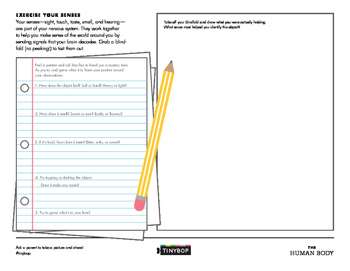Tinybop
854 Followers
Grade Levels
K - 9th
Subjects
Resource Type
Standards
CCSSW.K.2
CCSSW.K.8
CCSSW.1.2
CCSSW.1.8
CCSSW.2.2
Formats Included
- PDF
Pages
1 page
Tinybop
854 Followers
Description
Your senses—sight, touch, taste, smell, and hearing—are a part of your nervous system. They work together to help you make sense of the world around you by sending your brain signals to decode. Grab a blindfold (no peeking!) to test them out.
Directions:
Find a partner and ask him/her to hand you a mystery item. As you try and guess what it is, have your partner record your observations.
1) How does the object feel? Soft or hard? Heavy or light?
2) How does it smell? Sweet or sour? Earthy or flowery?
3) If it's food, how does it taste? Bitter, salty, or sweet?
4) Try tapping or shaking the object. Does it make any noise?
5) Try to guess what's in your hand.
Take off your blindfold and draw what you were actually holding. What sense most helped you identify this object?
Aligned with Next Generation Science Standards (NGSS):
K-LS1-1. Use observations to describe patterns of what plants and animals (including humans) need to survive.
1-LS1-1. Use materials to design a solution to a human problem by mimicking how plants and/or animals use their external parts to help them survive, grow, and meet their needs.
4-LS1-1. Construct an argument that plants and animals have internal and external structures that function to support survival, growth, behavior, and reproduction.4-LS1-2. Use a model to describe that animals receive different types of information through their senses, process the information in their brain, and respond to the information in different ways.
MS-LS1-3. Use argument supported by evidence for how the body is a system of interacting subsystems composed of groups of cells.
MS-LS1-8. Gather and synthesize information that sensory receptors respond to stimuli by sending messages to the brain for immediate behavior or storage as memories.
HS-LS1-2. Develop and use a model to illustrate the hierarchical organization of interacting systems that provide specific functions within multicellular organisms.
HS-LS1-3. Plan and conduct an investigation to provide evidence that feedback mechanisms maintain homeostasis.
Copy and paste the following link to your browser to download the app:
https://itunes.apple.com/us/app/the-human-body-by-tinybop/id682046579?mt=8
Directions:
Find a partner and ask him/her to hand you a mystery item. As you try and guess what it is, have your partner record your observations.
1) How does the object feel? Soft or hard? Heavy or light?
2) How does it smell? Sweet or sour? Earthy or flowery?
3) If it's food, how does it taste? Bitter, salty, or sweet?
4) Try tapping or shaking the object. Does it make any noise?
5) Try to guess what's in your hand.
Take off your blindfold and draw what you were actually holding. What sense most helped you identify this object?
Aligned with Next Generation Science Standards (NGSS):
K-LS1-1. Use observations to describe patterns of what plants and animals (including humans) need to survive.
1-LS1-1. Use materials to design a solution to a human problem by mimicking how plants and/or animals use their external parts to help them survive, grow, and meet their needs.
4-LS1-1. Construct an argument that plants and animals have internal and external structures that function to support survival, growth, behavior, and reproduction.4-LS1-2. Use a model to describe that animals receive different types of information through their senses, process the information in their brain, and respond to the information in different ways.
MS-LS1-3. Use argument supported by evidence for how the body is a system of interacting subsystems composed of groups of cells.
MS-LS1-8. Gather and synthesize information that sensory receptors respond to stimuli by sending messages to the brain for immediate behavior or storage as memories.
HS-LS1-2. Develop and use a model to illustrate the hierarchical organization of interacting systems that provide specific functions within multicellular organisms.
HS-LS1-3. Plan and conduct an investigation to provide evidence that feedback mechanisms maintain homeostasis.
Copy and paste the following link to your browser to download the app:
https://itunes.apple.com/us/app/the-human-body-by-tinybop/id682046579?mt=8
Total Pages
1 page
Answer Key
N/A
Teaching Duration
N/A
Report this resource to TPT
Reported resources will be reviewed by our team. Report this resource to let us know if this resource violates TPT’s content guidelines.
Standards
to see state-specific standards (only available in the US).
CCSSW.K.2
Use a combination of drawing, dictating, and writing to compose informative/explanatory texts in which they name what they are writing about and supply some information about the topic.
CCSSW.K.8
With guidance and support from adults, recall information from experiences or gather information from provided sources to answer a question.
CCSSW.1.2
Write informative/explanatory texts in which they name a topic, supply some facts about the topic, and provide some sense of closure.
CCSSW.1.8
With guidance and support from adults, recall information from experiences or gather information from provided sources to answer a question.
CCSSW.2.2
Write informative/explanatory texts in which they introduce a topic, use facts and definitions to develop points, and provide a concluding statement or section.


